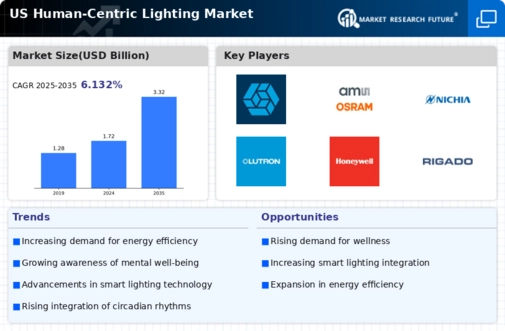Focus on Workplace Wellness Programs
The emphasis on workplace wellness programs is significantly shaping the human centric-lightings market. Companies are increasingly recognizing the importance of creating environments that support employee health and productivity. As part of these wellness initiatives, organizations are investing in human centric lighting solutions that align with their goals of enhancing employee satisfaction and performance. Research indicates that workplaces with optimized lighting can lead to a 30% reduction in absenteeism. This focus on wellness is driving companies to adopt advanced lighting technologies, thereby expanding the human centric-lightings market. The potential for improved employee well-being and productivity is likely to encourage further investments in this area.
Increased Awareness of Lighting Effects
The growing awareness of the impact of lighting on human health and productivity is driving the human centric-lightings market. Research indicates that appropriate lighting can enhance mood, reduce fatigue, and improve overall well-being. As organizations and individuals recognize these benefits, there is a notable shift towards implementing human centric lighting solutions. In the workplace, studies show that well-designed lighting can increase employee productivity by up to 20%. This awareness is prompting investments in advanced lighting technologies, which are projected to reach a market value of $5 billion by 2027. Consequently, the human centric-lightings market is experiencing a surge in demand as consumers seek to optimize their environments for better health outcomes.
Regulatory Support for Energy Efficiency
Regulatory frameworks promoting energy efficiency are significantly influencing the human centric-lightings market. The U.S. government has established various initiatives aimed at reducing energy consumption in commercial and residential buildings. These regulations often encourage the adoption of energy-efficient lighting solutions, including human centric lighting systems. For instance, the Energy Policy Act provides incentives for using energy-efficient technologies, which can lead to savings of approximately $1.5 billion annually. As a result, manufacturers are increasingly focusing on developing products that comply with these regulations, thereby expanding the human centric-lightings market. The alignment of market offerings with regulatory standards is likely to enhance consumer trust and drive further adoption.
Technological Integration in Smart Homes
The integration of human centric lighting within smart home systems is emerging as a key driver for the human centric-lightings market. As smart home technology becomes more prevalent, consumers are seeking lighting solutions that can be seamlessly integrated with other smart devices. This trend is supported by the increasing availability of smart lighting products that offer customizable settings based on user preferences and circadian rhythms. Market data suggests that the smart lighting segment is expected to grow at a CAGR of 25% over the next five years. This growth indicates a strong potential for human centric lighting solutions that adapt to individual needs, thereby enhancing the overall user experience and driving market expansion.
Rising Demand for Aesthetic Lighting Solutions
The aesthetic appeal of lighting is becoming increasingly important in the human centric-lightings market. Consumers are not only looking for functional lighting but also for designs that enhance the visual appeal of their spaces. This trend is particularly evident in residential applications, where homeowners are investing in stylish lighting fixtures that also promote well-being. The market for decorative lighting is projected to grow by 15% annually, reflecting a shift towards products that combine aesthetics with health benefits. As designers and manufacturers respond to this demand, the human centric-lightings market is likely to see a diversification of products that cater to both visual and functional needs.























Leave a Comment